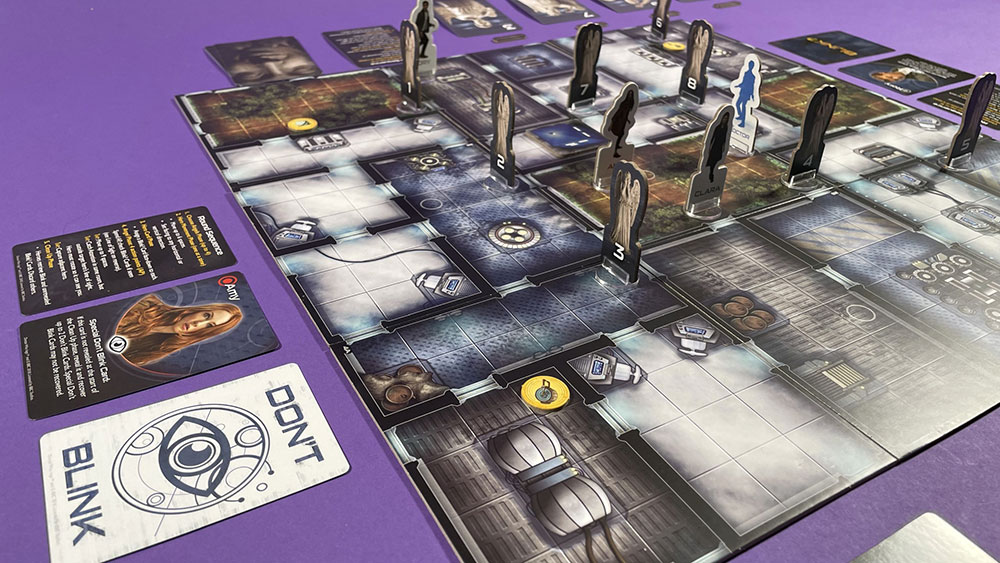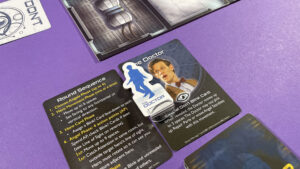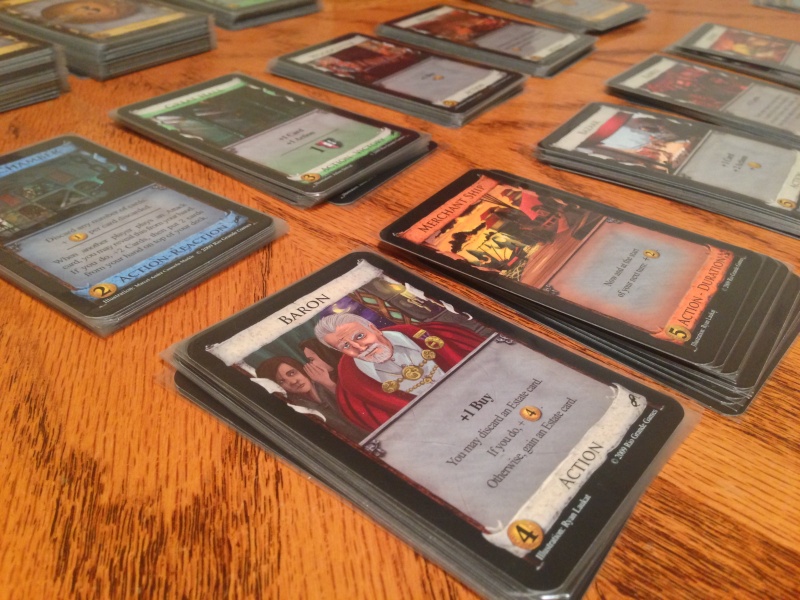 I never watched much Doctor Who but always loved the Don’t Blink episode and the idea of the Weeping Angels. The fact that the only way to really make it through an encounter with them was to keep your eyes open made them honestly one of the scarier monster concepts ever. So a game where you could try and outwit them was a game I could not pass up!
I never watched much Doctor Who but always loved the Don’t Blink episode and the idea of the Weeping Angels. The fact that the only way to really make it through an encounter with them was to keep your eyes open made them honestly one of the scarier monster concepts ever. So a game where you could try and outwit them was a game I could not pass up!
Don’t Blink is a one-versus-many game for 2 to 5 players that takes about 45 minutes to play. The best experience is with three players for challenging gameplay without the co-op infighting.
Gameplay Overview:
In Don’t Blink you need to decide which team you want to be on: the Weeping Angels (one player) or the Heroes (up to four players). The Heroes are The Doctor, Amy Pond, Rory Williams, and Clara Oswald, each with their own unique power. The game map is modular and creates a 3×3 grid with almost labyrinthian passages. Everyone chooses where they will start on the board before gameplay begins.
Each round has five phases: Choose Angels Phase, Hero Move Phase, Hero Card Phase, Angel Phase, and Clean Up Phase.

During the Choose Angels Phase, the Angel player selects which of their Weeping Angels standees is “real”, and they pick up all of the Angel Identification Cards, selecting up to 4 of them. During the Hero Move Phase, each of the heroes takes a turn which includes moving up to 6 spaces, choosing which direction to face, picking up repair parts, and even dragging Angel standees with them. The Hero Card Phase requires heroes to assign a Blink? card to themselves for the Angel Phase. In the Angel Phase, the Weeping Angels are activated and can move up to 9 spaces, catch the attention of a hero, or capture a hero. Blink? cards are only checked when a Weeping Angel is entering the line of sight of a hero. Any revealed Don’t Blink cards are discarded, making it more common to blink and less common to not blink.
Gameplay continues until all of the Repair Parts have been returned to the Tardis by the Heroes or if the Angel player captures all the heroes and steals their lifetimes.

Game Experience:
For this segment, I’ll be sharing my experience from both the Heroes’ perspective and the Angels’ perspective so you can figure out if this game is for you and which role would be the best fit. Some of you may enjoy being the one versus the many, and some of you may prefer to work as a team. This game thankfully has something for both styles!
For my Heroes out there, if you’ve ever seen these monsters in action during Doctor Who you’ll feel right at home as trying to sneak around the map is nerve-racking. Incorporating the facing or not facing mechanic makes this game even more interesting and immersive, giving you a chance to have some fun big brain energy with either yourself (if playing 1v1) or your teammates.

A surprising aspect of this game that only came up while moving heroes were configurations in which all lines of sight are covered can be countered by limited Don’t Blink cards. It’s almost as if you don’t want the Angels to have to check if you blink or not. On the other hand, the angel player sneak-ups are tough to counter. Since they have two action points, they can easily move and then capture you if you’re alone. However, the problem with trying to stick together to prevent a sneak attack is that the parts are spread out across the map and it almost seems more prudent to try and split up first. With all this being said it’s clear that the designers did not want to make the path forward easy for you, and it’s in this puzzle of finding the right approach for the moment that makes playing the Heroes quite challenging.

For my chaotic ne’er-do-well, it may look like I’ve presented you with an easy win but don’t be deceived; it’s actually quite hard to descend on the Heroes as the Angels since planning who is a “real” angel round-to-round can be nebulous for you. You cannot move “fake” angels and they are more there for the heroes to be tricked by, which can be a fun minigame if you’re clever or just cumbersome if you’re not. My one complaint is figuring out the frozen state as the Angels when they are in a line of sight of each other can knock out two of your four “real” standees if you’re not careful. Heroes can also drag your pieces around and if they are able to guess which are real they can force a frozen state to render your turn completely useless.
For both roles, the initial setup and first movements can be scary. You’ll actually feel pretty unsure of anything that you do as Heroes make their way to the parts they need, or wiggling around the Heroes’ starting positions as the Angels. Heroes will most likely make aggressive moves with their limited movement speed towards the locations of the parts but will quickly feel the Angels’ higher movement speed close in around them. It’s this sprint and then sudden stop that can take a bit too long with higher player counts because the opposite roles are almost eyeing each other, figuring out how to make counter moves as the game progresses. I haven’t quite figured out how to prevent this odd pace but it seems common in your first few plays.

In my playthroughs so far, this game would overall not be good with more than two players, even though you can play up to five. The one exception to this would be if you had a gaming group that was very good at communicating, perhaps knew each other for years, and had a good cooperative dynamic. Absolutely would not recommend this in a random group at a meetup unless you were in the mood for a headache. I haven’t tried any of the other difficulty levels yet but I appreciate that the rulebook gives you options on how to ensure that gameplay is not stale and also provides bragging rights to anyone that likes to master these kinds of games.
Final Thoughts:
Don’t Blink is for anyone wanting a new and challenging experience that feels balanced throughout. The gameplay is full of puzzles, almost minigames, on how to navigate the limitations and powers of both roles. However, if you’re not prepared to go to mental or tactical war with your friends, sadly I would not recommend this game to play, even with strangers. I don’t suspect that gameplay will become stale as player count and even difficulty modes can provide a new experience and replayability.
Final Score: 4 Stars – Dive into the world of Doctor Who and the Weeping Angels in this one-versus-many cooperative game.
 Hits:
Hits:
• Fun even for non-fans
• Balanced roles
• Still challenging as 1v1
Misses:
• Too much infighting with Heroes
• Real vs fake Angels can confuse
• Slow start can be a bore






















